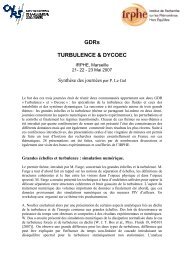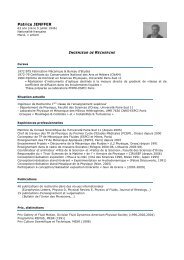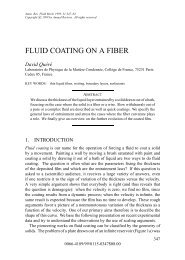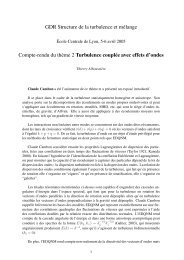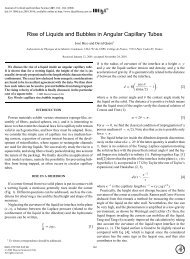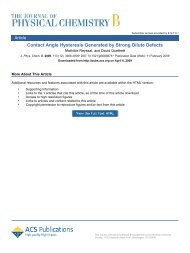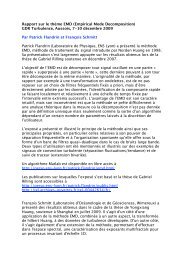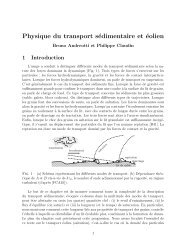Drag reduction through self-similar bending of a flexible body
Drag reduction through self-similar bending of a flexible body
Drag reduction through self-similar bending of a flexible body
- No tags were found...
Create successful ePaper yourself
Turn your PDF publications into a flip-book with our unique Google optimized e-Paper software.
..............................................................<strong>Drag</strong> <strong>reduction</strong> <strong>through</strong> <strong>self</strong>-<strong>similar</strong><strong>bending</strong> <strong>of</strong> a <strong>flexible</strong> <strong>body</strong>Silas Alben*, Michael Shelley* & Jun Zhang*†* Applied Mathematics Laboratory, Courant Institute <strong>of</strong> Mathematical Sciences,New York University, New York City, New York 10012, USA† Department <strong>of</strong> Physics, New York University, New York City, New York 10003,USA.............................................................................................................................................................................The classical theory <strong>of</strong> high-speed flow 1 predicts that a movingrigid object experiences a drag proportional to the square <strong>of</strong> itsspeed. However, this reasoning does not apply if the object in theflow is <strong>flexible</strong>, because its shape then becomes a function <strong>of</strong> itsspeed—for example, the rolling up <strong>of</strong> broad tree leaves in a stiffwind 2 . The reconfiguration <strong>of</strong> bodies by fluid forces is common innature, and can result in a substantial drag <strong>reduction</strong> that isbeneficial for many organisms 3,4 . Experimental studies <strong>of</strong> suchflow–structure interactions 5 generally lack a theoreticalinterpretation that unifies the <strong>body</strong> and flow mechanics. Herewe use a <strong>flexible</strong> fibre immersed in a flowing soap film to measurethe drag <strong>reduction</strong> that arises from <strong>bending</strong> <strong>of</strong> the fibre by theflow. Using a model that couples hydrodynamics to <strong>bending</strong>, wepredict a reduced drag growth compared to the classical theory.The fibre undergoes a <strong>bending</strong> transition, producing shapes thatare <strong>self</strong>-<strong>similar</strong>; for such configurations, the drag scales with thelength <strong>of</strong> <strong>self</strong>-<strong>similar</strong>ity, rather than the fibre pr<strong>of</strong>ile width. Thesepredictions are supported by our experimental data.Experiments that cleanly reveal the nature <strong>of</strong> interactionsbetween deformable bodies and flows are difficult to perform.Complications include controlling three-dimensional flow effectsand visualizing the flows. Soap film is a convenient experimentalsystem described by two-dimensional hydrodynamics in manyaspects 6–10 . Our soap-film flow tunnel is illustrated in Fig. 1. Drivenby gravity, soapy water (1.5% Dawn dish detergent; densityr ¼ 1gmcm 23 ) leaves an elevated reservoir and spreads into avertical soap film (thickness f ¼ 1–3 mm) descending between twostraight nylon lines (tunnel width, 9.0 cm). Adjusting reservoirefflux rate adjusts flow velocity U <strong>through</strong> the range 0.5–3.0 m s 21 ; breakage occurs at velocities outside this range.Half-way down the tunnel, a thin, <strong>flexible</strong> glass fibre (lengthL ¼ 1–5 cm; diameter, 34 mm; rigidity E ¼ 2.8 erg cm), glued at itsmidpoint to a thin rod, is inserted transverse to the flow. Wemeasure the drag force on the fibre, record its shape, and visualizethe flow structures using interferometry, all as a function <strong>of</strong> flowspeed. For comparison, a much more rigid fibre is also used(L ¼ 2.0 cm; E ¼ 2,000 erg cm). On the basis <strong>of</strong> fibre lengths, flowvelocities, and soap film viscosity n, the Reynolds number Re ¼ LU/nis typically large, in the range 2,000–40,000.Figure 2a and b shows the flow patterns around a <strong>flexible</strong> fibre attwo different flow speeds. Typical <strong>of</strong> high-Reynolds-number flowspast bluff bodies, they are characterized by a thin separatedboundary layer which divides the wake—containing slow-moving(a few cm s 21 ), turbulent flow in which vorticity and viscosity areimportant—from the rest <strong>of</strong> the flow field, which is fast and laminar.But unlike rigid-<strong>body</strong> flows, as the flow speed is increased the <strong>body</strong>changes its shape by <strong>bending</strong> and so presents a smaller pr<strong>of</strong>ile to theflow. Figure 3a shows in alternating colour the successively morestreamlinedfibre shapes as flow speed is increased. We expect this tolead to a reduced growth <strong>of</strong> drag with flow speed, and this is borneout by Fig. 4a, which compares the drag induced by a nearly rigidfibre, well-approximated by U 2 growth, with that for a <strong>flexible</strong> fibre,which shows a much decreased, more slowly growing drag. Anupper bound for the contribution <strong>of</strong> skin friction to the drag can beestimated by the expression for viscous drag per unit width on a flatletters to natureplate aligned with the flow 1 , 1.33rU 2 LRe 21/2 . For the parameters <strong>of</strong>our experiment, this value is at least an order <strong>of</strong> magnitude belowthe total drag; hence form drag predominates.As we shall argue, a natural non-dimensional control parameterthat scales linearly with flow velocity is:h ¼ rfL2 U 2 1=2=2¼ðL=L 0 Þ 3=2 with L 0 ¼ð2E=rfU 2 Þ 1=3 ð1ÞE=LHere, h involves a ratio <strong>of</strong> fluid kinetic energy to elastic potentialenergy, or the ratio <strong>of</strong> fibre length to an intrinsic ‘<strong>bending</strong> length’ L 0 ,which captures the competition between fibre rigidity and fluidforcing. Loaded elastic bodies <strong>of</strong>ten involve intrinsic length scales,such as the ‘buckling length’ <strong>of</strong> a beam under compression 11 .Tostudy the scaling <strong>of</strong> drag with flow speed, we introduce the dragcoefficient C D ¼ <strong>Drag</strong>=ðrU 2 Lf =2Þ; which for a rigid object ininviscid flow depends only on its geometric shape 1 . A non-dimensionaldrag is defined as D ¼ C D h 2 so that D scales with h as the dragscales with velocity. Figure 4b plots D versus h. The data for a nearlyrigid fibre (green) show approximately h 2 growth. The other datasets are for <strong>flexible</strong> fibres <strong>of</strong> equal rigidity but different lengths. Thedata for the longest fibre (blue) deviate at lower flow velocities,probably induced by proximity to the channel walls, but as the fibrepr<strong>of</strong>ile narrows with increasing h, the data sets overlap. It appearsthat there is a transition at h < O(1) from h 2 scaling <strong>of</strong> drag to anew, more slowly growing form.To interpret the experiment, we abstract its crucial features andbuild a mathematical model coupling hydrodynamics to <strong>body</strong>flexibility. The fibre is modelled as a thin, inextensible elasticbeam loaded by the difference in fluid pressure p between itsupstream and downstream sides. The pressure is found by constructingexact, steady solutions to the inviscid, incompressibleEuler equations, using free-streamline theory 12 (FST). This method,based upon conformal mapping, originated 13 as a way to modelflows around flat plates with a downstream wake. It has since beenextended as a numerical method to compute flows around curvedshapes, and to determine the shapes <strong>of</strong> sails under constantFigure 1 The layout <strong>of</strong> the experiment. A glass fibre (F) is inserted into a flowing soap-filmtunnel (partly shown). The fibre is supported by a thin stainless-steel rod (S), which isclamped at one end. Fluid drag force acting on the fibre deflects this support slightlydownwards. After a calibration using a known force, the drag force is determined bymeasuring the displacement <strong>of</strong> a laser beam (L) reflected from a small mirror (M1)mounted on S and then from a fixed mirror (M2). The rigidity <strong>of</strong> the support and thedistances between the mirrors and the ruler (R) determine the overall sensitivity <strong>of</strong> themeasurement. A video camera (V) records the position <strong>of</strong> the laser beam, which gives theforce measurement. The soap solution is seeded with TiO 2 particles, allowing the flowspeed to be measured by a laser Doppler velocimeter (not shown), aimed at the midline7 cm above the filament. (Objects and distances are not drawn to scale).NATURE | VOL 420 | 5 DECEMBER 2002 | www.nature.com/nature © 2002 Nature Publishing Group479
letters to natureFigure 4 Comparison <strong>of</strong> drag data from experiment and model. a, <strong>Drag</strong> per unit fibrelength versus flow velocity for a <strong>flexible</strong> fibre (L ¼ 3.3 cm; red circles) and a rigid fibre(L ¼ 2.0 cm; green squares). b, Log–log plot <strong>of</strong> drag data in a, non-dimensionalized asD ¼ C D h 2 ; also shown are data for two fibres with the same rigidity as the <strong>flexible</strong> fibre ina but different lengths (pink plus signs, L ¼ 1.8 cm; blue triangles, L ¼ 5.2 cm). Thesolid line is the values <strong>of</strong> D in the model (well-fitted by power laws h 2 for h ,, 1 and h 4/3for h . 1, as shown by dash-dotted lines). The short-dashed line is the solid line shiftedby a factor <strong>of</strong> 2.8 in h, to correspond with the shift in the shape comparison. This shiftcompensates for the ‘back pressure’ in the wake, as explained in the text.shows a detailed solution, and Fig. 3a shows computed fibre shapesfor h small to large. For h , 1, the fibre is nearly straight, but as hbecomes O(1) there is a sharp transition to <strong>bending</strong>. The mostnotable property <strong>of</strong> the transition is an emerging <strong>self</strong>-<strong>similar</strong>ity infibre shape. For h . 1, large curvature becomes confined to anever-smaller region near the tip as h increases. The length <strong>of</strong> this ‘tipregion’ is proportional to the <strong>bending</strong> length, L 0 ¼ Lh 22=3 : This setsthe scale for <strong>self</strong>-<strong>similar</strong>ity: when dilated by h 2/3 the shapes overlap auniversal, quasi-parabolic form (Fig. 3d). The transition is alsocaptured in the computed dimensionless drag D (Fig. 4b). Forh ,, 1 the model’s drag scales quadratically, as does the experimentaldata; for h < O(1), the model’s drag undergoes a transition to amuch slower growth, scaling as h 4/3 for h . 1.Self-<strong>similar</strong>ity <strong>of</strong> shape gives an interpretation for the h 4/3 dragscaling.Rescaling arc length as S ¼ sh 2/3 , curvature as h 2/3Kðsh 2=3 Þ¼kðsÞ; and pressure as Pðsh 2=3 Þ¼pðsÞ; equation (3)becomes K 3 =2 þ K 00 ¼ P; with h appearing only in the boundaryconditions: K ¼ K 0 ¼ 0atS ¼ ^h 2=3 =2: As h !1, K and P tend tothe curvature and pressure <strong>of</strong> the universal shape. The drag is givenbyD ¼ h 2 ðfibreð þh 2=3½pŠ dy ¼ h 4=3 =2 1 dY2 K3 þ K 00dS dS2h 2=3 =2where Y ¼ yh 2=3 : As h !1, the integral converges to its value forthe universal shape, and hence the drag scales as the prefactor h 4/3 .Figure 3a compares computed to experimental shapes for the fullrange <strong>of</strong> flow speeds. Aligning the midpoints, the relative displacementfrom the midpoint between the experimental shape and thenearest computed shape is less than five per cent over the entireð4Þlength. Figure 3c indicates the emergence <strong>of</strong> <strong>self</strong>-<strong>similar</strong>ity in theexperimental shapes, as in the computed shapes, though the upperlimit on the soap-film flow speed impedes a thorough comparisonfor large h. In Fig. 3b the measured drag for the fibres is compared tothat <strong>of</strong> their nearest computed solutions, demonstrating that the<strong>similar</strong> shapes in theory and experiment also give <strong>similar</strong> drags. Weinterpret this to mean that the model captures the nature <strong>of</strong> thepressure jump distribution across the fibre.Through this comparison, we obtain a quantitative estimate forthe multiplicative increase <strong>of</strong> h needed for the model to account forthe wake pressure and its effect on the drag. The values <strong>of</strong> h for thecorresponding theoretical and experimental fibre shapes <strong>of</strong> Fig. 3adiffer by an almost uniform factor <strong>of</strong> 2.8. In Fig. 4b, the model andexperiment show very <strong>similar</strong> drag scaling and transition when thetheoretical curve is shifted leftward in h to adjust for this factor.Fluid pressure and elastic <strong>bending</strong> forces seem sufficient todescribe the drag <strong>reduction</strong> observed in our experiment. Thoughnegligible for our flow speeds, skin friction may become importantin much faster flows, where the fibre would be more swept-back,like a flat plate aligned with the flow. As implied earlier, the viscousdrag on the fibre would then scale as U 3/2 , eventually dominatingthe U 4/3 form drag.A final comment concerns the relation <strong>of</strong> <strong>bending</strong> length to drag.Two-dimensional form drag usually scales as rU 2 W, where W ispr<strong>of</strong>ile width. In our case, the parabolic form <strong>of</strong> the universal shapeimplies that W decreases as h 21/3 . Hence one would expect D , h 5/3 .Instead we find that the drag is induced on the <strong>bending</strong> length L 0 ,h 22=3 ; giving the more slowly growing form D , h 4/3 . In essence, thetip region creates a parabolic wake in which the rest <strong>of</strong> the <strong>body</strong> sits,contributing little to the drag.AReceived 13 August; accepted 14 October 2002; doi:10.1038/nature01232.1. Batchelor, G. K. An Introduction to Fluid Dynamics (Cambridge Univ. Press, Cambridge, 1967).2. Vogel, S. <strong>Drag</strong> and reconfiguration <strong>of</strong> broad leaves in high winds. J. Exp. Bot. 40, 941–948 (1989).3. Denny, M. Extreme drag forces and the survival <strong>of</strong> wind-swept and water-swept organisms. J. Exp.Biol. 194, 97–115 (1994).4. Koehl, M. How do benthic organisms withstand moving water? Am. Zool. 24, 57–70 (1984).5. Vogel, S. Life in Moving Fluids (Princeton Univ. Press, Princeton, 1994).6. Couder, Y., Chomaz, J. M. & Rabaud, M. On the hydrodynamics <strong>of</strong> soap films. Physica D 37, 384–405(1989).7. Gharib, M. & Derango, P. A liquid-film (soap film) tunnel to study two-dimensional laminar andturbulent shear flows. Physica D 37, 406–416 (1989).8. Goldburg, W. I., Rutgers, M. A. & Wu, X.-L. Experiments on turbulence in soap films. Physica A 239,340–349 (1997).9. Rutgers, M. A., Wu, X.-L. & Daniel, W. B. Conducting fluid dynamics experiments with verticallyfalling soap films. Rev. Sci. Instrum. 72, 3025–3037 (2001).10. Zhang, J., Childress, S., Libchaber, A. & Shelley, M. Flexible filaments in a flowing soap film as a modelfor one-dimensional flags in a two-dimensional wind. Nature 408, 835–839 (2000).11. Segel, L. Mathematics Applied to Continuum Mechanics (MacMillan, New York, 1977).12. Birkh<strong>of</strong>f, G. & Zarantonello, E. H. Jets, Wakes, and Cavities (Academic, New York, 1957).13. Helmholtz, H. Uber discontinuierliche Flussigkeitsbewegungen. Monatsber. Berlin Akad. 215–268(1868); reprinted in Phil. Mag. 36, 337–346 (1868).14. Dugan, J. P. A free-streamline model <strong>of</strong> the two-dimensional sail. J. Fluid Mech. 42, 433–446 (1970).15. Rivera, M., Vorobieff, P. & Ecke, R. E. Turbulence in flowing soap films: velocity, vorticity, andthickness fields. Phys. Rev. Lett. 81, 1417–1420 (1998).16. Rivera, M. & Wu, X.-L. External dissipation in driven two-dimensional turbulence. Phys. Rev. Lett. 85,976–979 (2000).17. Hureau, J., Brunon, E. & Legallais, P. Ideal free streamline flow over a curved obstacle. J. Comput. Appl.Math. 72, 193–214 (1996).18. Wu, T. Y. Cavity and wake flows. Annu. Rev. Fluid Mech. 4, 243–284 (1972).19. Smith, F. T. Laminar flow <strong>of</strong> an incompressible fluid past a bluff <strong>body</strong>: the separation, reattachment,eddy properties and drag. J. Fluid Mech. 92, 171–205 (1979).20. Goldstein, R. E. & Langer, S. A. Nonlinear dynamics <strong>of</strong> stiff polymers. Phys. Rev. Lett. 75, 1094–1097(1995).Acknowledgements We thank F. Vollmer, S. Childress, A. Libchaber and P. Palffy-Muhoray forconversations, and Y.-Q. Xia who assisted in a preliminary experimental study <strong>of</strong> the fibre/flowsystem. M.S. thanks A. Goriely, who originally suggested this as an interesting problem. This workwas supported by the National Science Foundation and the Department <strong>of</strong> Energy.Competing interests statement The authors declare that they have no competing financialinterests.Correspondence and requests for materials should be addressed to M.S.(e-mail: shelley@cims.nyu.edu).NATURE | VOL 420 | 5 DECEMBER 2002 | www.nature.com/nature © 2002 Nature Publishing Group481



